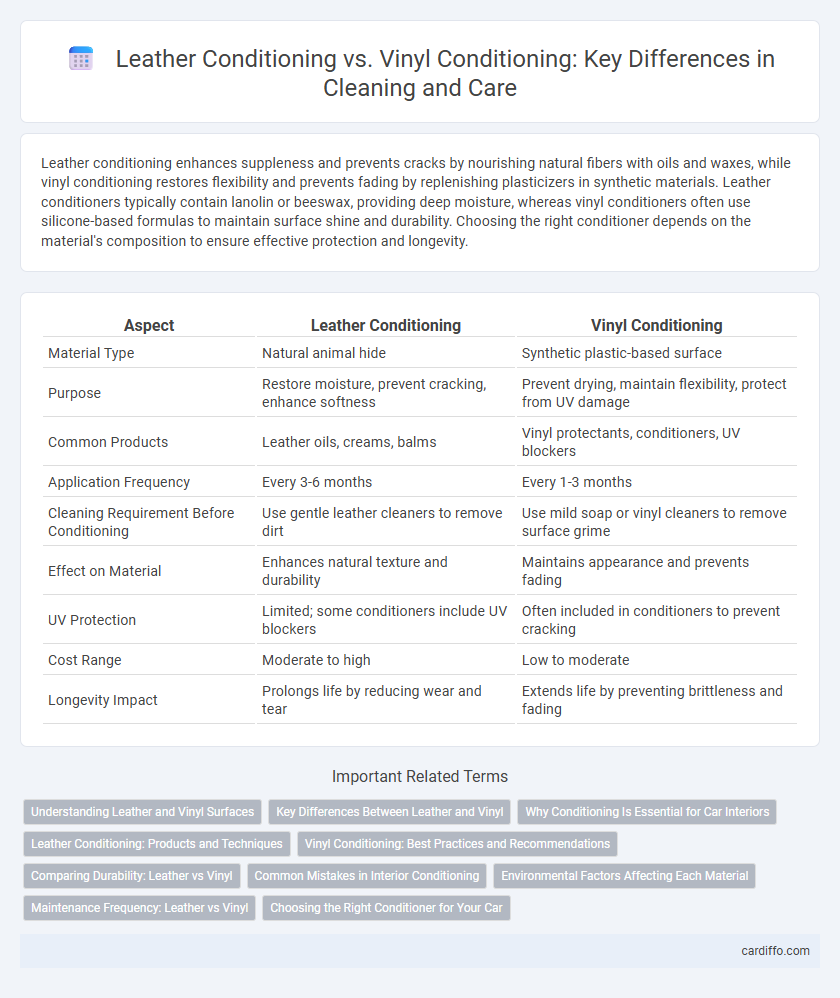Leather conditioning enhances suppleness and prevents cracks by nourishing natural fibers with oils and waxes, while vinyl conditioning restores flexibility and prevents fading by replenishing plasticizers in synthetic materials. Leather conditioners typically contain lanolin or beeswax, providing deep moisture, whereas vinyl conditioners often use silicone-based formulas to maintain surface shine and durability. Choosing the right conditioner depends on the material's composition to ensure effective protection and longevity.
Table of Comparison
| Aspect | Leather Conditioning | Vinyl Conditioning |
|---|---|---|
| Material Type | Natural animal hide | Synthetic plastic-based surface |
| Purpose | Restore moisture, prevent cracking, enhance softness | Prevent drying, maintain flexibility, protect from UV damage |
| Common Products | Leather oils, creams, balms | Vinyl protectants, conditioners, UV blockers |
| Application Frequency | Every 3-6 months | Every 1-3 months |
| Cleaning Requirement Before Conditioning | Use gentle leather cleaners to remove dirt | Use mild soap or vinyl cleaners to remove surface grime |
| Effect on Material | Enhances natural texture and durability | Maintains appearance and prevents fading |
| UV Protection | Limited; some conditioners include UV blockers | Often included in conditioners to prevent cracking |
| Cost Range | Moderate to high | Low to moderate |
| Longevity Impact | Prolongs life by reducing wear and tear | Extends life by preventing brittleness and fading |
Understanding Leather and Vinyl Surfaces
Leather conditioning involves nourishing natural animal hide with oils and waxes to maintain flexibility and prevent cracking, while vinyl conditioning focuses on treating synthetic polymer surfaces to restore softness and prevent fading. Understanding the porous, breathable nature of leather is essential for selecting conditioners that penetrate deeply without causing damage, whereas vinyl requires conditioners that form a protective, non-penetrating layer to avoid surface degradation. Proper conditioning methods enhance durability, appearance, and longevity tailored specifically to the leather's natural fibers or the vinyl's synthetic makeup.
Key Differences Between Leather and Vinyl
Leather conditioning involves nourishing natural animal hide with oils and conditioners to maintain softness, prevent cracking, and enhance durability, while vinyl conditioning focuses on preserving synthetic polymer surfaces by preventing drying and cracking through protective treatments. Leather's porous and fibrous nature requires moisturizers that penetrate deeply, whereas vinyl's non-porous, plasticized surface demands conditioners that shield against UV damage and surface brittleness. The key differences lie in material composition, absorption properties, and the specific conditioning agents designed to maintain each surface's integrity and appearance.
Why Conditioning Is Essential for Car Interiors
Conditioning leather in car interiors prevents drying, cracking, and fading by replenishing natural oils and maintaining flexibility, while vinyl conditioning restores suppleness and prevents brittle texture caused by heat and UV exposure. Both leather and vinyl conditioners form protective barriers against dirt, stains, and harmful UV rays, extending the lifespan and preserving the aesthetic appeal of car interiors. Regular conditioning enhances comfort, maintains resale value, and reduces the need for costly repairs or replacements.
Leather Conditioning: Products and Techniques
Leather conditioning requires specialized products such as natural oils, leather balms, and pH-balanced conditioners designed to nourish and preserve the material's suppleness. Techniques include applying a small amount of conditioner evenly with a soft cloth, allowing it to absorb fully, and then buffing to restore the leather's natural luster. Proper conditioning protects against cracking, fading, and moisture damage, extending the lifespan and appearance of leather goods.
Vinyl Conditioning: Best Practices and Recommendations
Vinyl conditioning requires specialized products designed to maintain flexibility and prevent cracking, unlike leather conditioners which focus on moisture retention. Best practices for vinyl conditioning include using pH-balanced, non-toxic conditioners applied with a soft cloth to avoid surface damage. Regular cleaning with mild soap followed by conditioning ensures longevity and preserves the material's appearance while preventing UV damage and drying.
Comparing Durability: Leather vs Vinyl
Leather conditioning enhances natural fibers, improving flexibility and resistance to cracking, which significantly extends its lifespan compared to vinyl. Vinyl conditioning maintains the surface's suppleness and prevents brittleness but typically offers shorter durability due to its synthetic composition. In environments with frequent use, leather conditioned properly lasts longer and withstands wear better than vinyl, making it a superior choice for durability.
Common Mistakes in Interior Conditioning
Leather conditioning often requires specialized products to maintain suppleness and prevent cracking, while vinyl conditioning focuses on preserving flexibility and avoiding brittleness. Common mistakes include using inappropriate cleaners, such as harsh detergents on leather that strip natural oils or silicone-based conditioners on vinyl that cause buildup and discoloration. Proper identification of material type and selecting targeted conditioners prevent damage and extend the lifespan of automotive interior surfaces.
Environmental Factors Affecting Each Material
Leather conditioning requires attention to humidity and temperature, as excessive moisture can cause mold growth while dryness leads to cracking. Vinyl conditioning is highly influenced by UV exposure and temperature fluctuations, which can cause fading, brittleness, and peeling. Both materials demand tailored maintenance based on their sensitivity to environmental factors for prolonged durability.
Maintenance Frequency: Leather vs Vinyl
Leather conditioning typically requires maintenance every 3 to 6 months to prevent drying and cracking, as natural oils need replenishment. Vinyl conditioning can be performed more frequently, often monthly, due to its non-porous surface that benefits from regular cleaning and protection against UV damage. Proper maintenance frequency ensures longevity and preserves the appearance of both materials.
Choosing the Right Conditioner for Your Car
Selecting the right conditioner for your car depends on the material type; leather conditioning products contain nourishing oils and moisturizers specifically designed to prevent leather from drying, cracking, and fading. Vinyl conditioners focus on protecting synthetic surfaces by creating a protective barrier that resists UV damage and maintains flexibility without leaving a greasy residue. Properly matching the conditioner to leather or vinyl surfaces ensures long-lasting protection, enhanced appearance, and preservation of the interior's value.
Leather Conditioning vs Vinyl Conditioning Infographic

 cardiffo.com
cardiffo.com